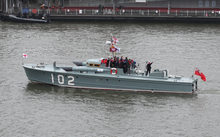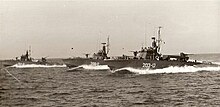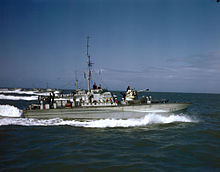Motor torpedo boat
With no significant armour, the boats relied upon surprise and agility at high speed to avoid being hit by gunfire from bigger ships.The Royal Navy started developing particularly small, agile, and fast petrol-powered torpedo boats in the early 20th century, shortly before the beginning of the First World War.MAS 15 was the only motor torpedo boat in history to sink a battleship, the Austro-Hungarian vessel Szent István in 1918.A similar size boat with a different role in the Second World War was the BPB 63 ft (19 m) high-speed launch used by the RAF for air-sea rescue operations.She was at Dunkirk in 1940 for the evacuation of British and French troops, where she served as Rear-Admiral Frederic Wake-Walker's flagship after the destroyer HMS Keith was sunk.In the early days of the war, they were painted with different numbers and photos distributed to the press to give the impression the Royal Navy had more than they actually did.Larger than earlier MTB or motor gun boat (MGB) designs, the Fairmile D was driven by four Packard 12-cylinder 1250 horsepower supercharged petrol engines and could achieve 29 knots (54 km/h; 33 mph) at full load.The boat carried 5,200 gallons of 100 octane fuel for a range, at maximum continuous speed, of 506 nautical miles.Originally designed as motor gun boats (MGBs), carrying a 6-pounder (57mm, 2.24 inch) to engage enemy small craft, they were re-designated MTBs.Scott-Paine type G 70 foot boat After the end of World War II a number of Royal Navy vessels were stripped and sold for use as houseboats.[citation needed] More MTB houseboats can be found at Shoreham-by-Sea (West Sussex), Cobden Bridge (Southampton) and Bembridge (Isle of Wight).




MTB 102Dunkirk evacuationtorpedo boatpetrolmarinisedsteam turbinesreciprocating steam enginesdieselinternal combustion enginesRoyal NavyRoyal Canadian NavySecond World WarUS NavyPT boathull classification symbolS-booteKriegsmarineE-boatsMAS boatsfast attack craftTorpedo boatsFirst World Warcoastal motor boatsItalianSzent IstvánCoastal ForcesBPB 63 ft (19 m)high-speed launchDark classGay classpatrol boatsBrave-class fast patrol boatsPeter Du CaneVosper LtdAdmiraltyIsotta Fraschinitorpedo tubes20mm OerlikonDunkirkevacuation of British and French troopsFrederic Wake-WalkerHMS KeithWinston ChurchillDwight EisenhowerInvasion of NormandyBritish Power Boat Company Type Two 63 ft HSLRoyal Air ForceSpecial Service VesselHMS Fidelity40 CommandoConvoy ON 154Packard V1-12 marine enginesdepth chargesRomaniaNMS ViscolulVosper 73 ft motor torpedo boat"Vosper 73ft"Oerlikon 20 mm cannon0.303 inVickers K machine gunsVickers .50 machine gunsQF 6-pdr Mark IIA gunPolish NavyFairmile D motor torpedo boatmotor gun boatHubert Scott-PaineCanadian Power Boat Company29th MTB Flotillamotor gun boatsauto-loading QF 6-pounderVickers machine guns40 mm Bofors gunRolls-RoycePackardradius of actionWorld War IIChichester CanalLangstone HarbourLittlehamptonHayling IslandWootton CreekShoreham-by-SeaCobden BridgeBembridgeBattle of Rumani CoastCoastal Forces of the Royal NavyE-boatHNoMS NastyMotor gunboatMotor LaunchOperation AgreementSwift boatUnited States Nasty-class patrol boatWooden boats of World War 26-pounder anti-tank gunNaval shipswarshipsNaval ship classes in servicesubmarineauxiliaryOperational zonesBrown-water navyGreen-water navyBlue-water navyBroadsideCentral batteryCasemateTurretsAircraft carriersAircraft cruiserAmphibious assault shipAnti-submarine warfare carrierBalloon carrierBattlecarrierCAM shipEscort carrierFighter catapult shipFleet carrierFlight deck cruiserHelicopter carrierInterdiction Assault ShipLight aircraft carrierMerchant aircraft carrierSeaplane tenderSupercarrierBattleships